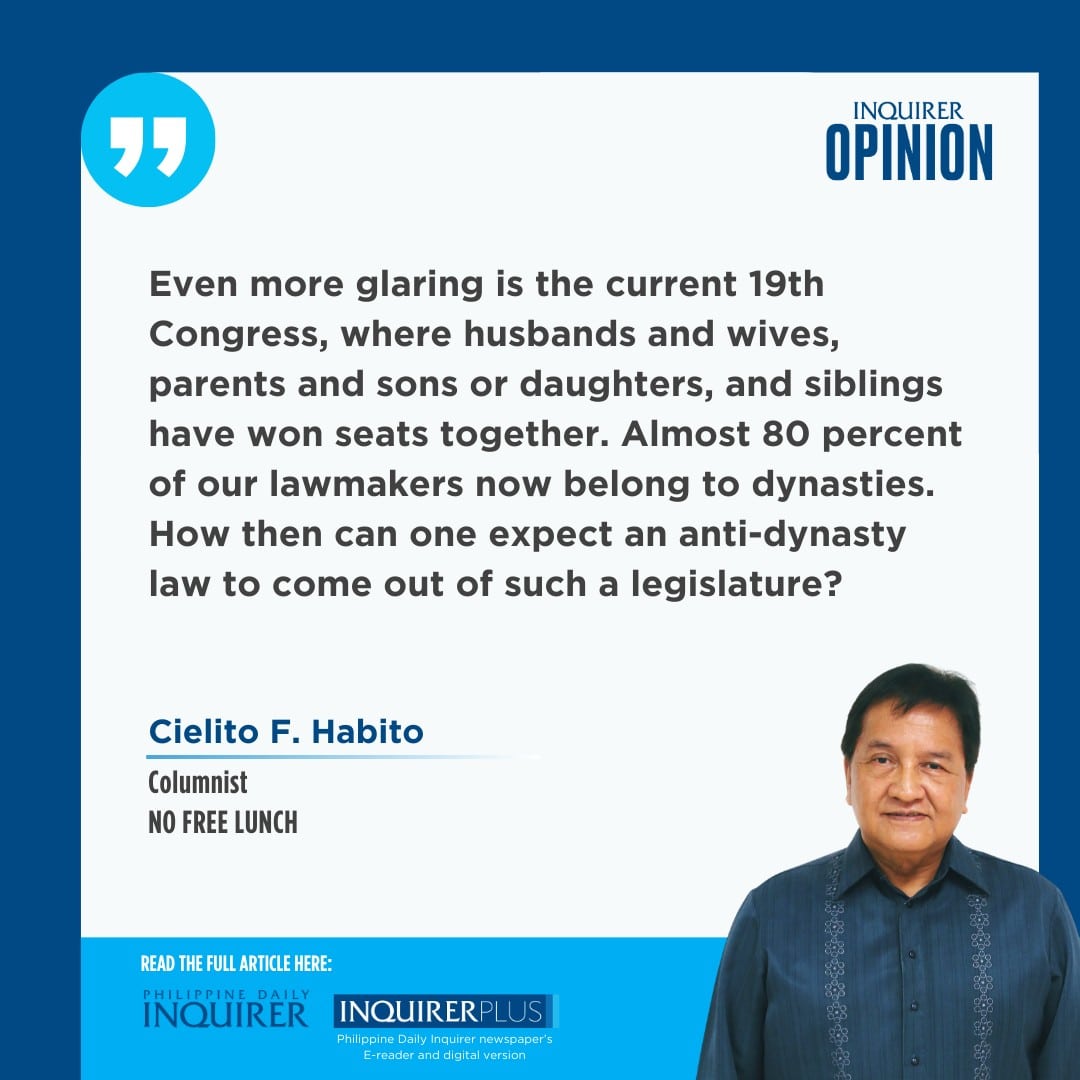Some hopes must have run high when another newspaper bannered last month that the Supreme Court had moved to compel Congress to finally pass a law defining political dynasties, which our 1987 Constitution expressly prohibits. Article II Section 26 asserts: “The State shall guarantee equal access to opportunities for public service and prohibit political dynasties as may be defined by law.” The report added that the Court considered the latter’s failure to pass the enabling law to implement the ban to be a grave abuse of discretion, and represents a continuing violation of the Constitution.
But it all turned out to be a mistake. The paper had to apologize the following day, admitting it had misinterpreted the Court’s posting on its website of petitions and other pleadings asking it to compel Congress to pass such a law. The Court clarified that all remain pending, including one such petition that a group of lawyers filed last March. Some expect that the high court would invoke separation of powers and avoid any such action that might be seen as encroaching on the powers of Congress as a co-equal body. The enabling law required to implement the constitutional ban on dynasties may yet remain a dream after 37 years, and still counting.
It’s not for lack of bills filed in Congress. Numerous bills have been filed since 1987, but Congress simply passed them over. In more recent memory, the late former senator Miriam Defensor Santiago filed anti-dynasty bills in the 15th and 16th Congresses. So did former senators Franklin Drilon, Panfilo Lacson, and Francis Pangilinan, the last being in the 18th Congress in 2019. Similar bills had been filed in the House of Representatives, including by Speaker Feliciano Belmonte Jr. and various party list and district lawmakers in the 16th Congress. Most recently, Sen. Robin Padilla, as chair of the Senate committee on constitutional amendments and revision of codes, filed Senate Bill No. 2730 “seeking to finally fulfill the 1987 Constitution’s mandate to prohibit political dynasties.” Padilla cites findings by scholars documenting the harm dynasties have done, and how they have become more and more prevalent in the Philippines over the years.
Studies distinguish between “fat” and “thin” dynasties: the first is when family members hold simultaneous government positions (“sabay-sabay”), while the latter is when family members succeed each other in the same position (“sunod-sunod”). Either way, the Philippines appears to have earned the “dynasty capital of the world” tag that Santiago described us to be. A group of Ateneo de Manila University researchers led by Dr. Ronald Mendoza noted that looking at legislators alone, 75 percent belonged to dynasties in 2013. The same figure was 6 percent in the United States, 10 percent in Argentina and Greece, 22 percent in Ireland, 24 percent in India, 33 percent in Japan, 40 percent in Mexico, and 42 percent in Thailand—all far below us.
Apart from much higher incidence, Philippine dynasties kept expanding over time, quite unlike experience elsewhere where dynasties have declined. A 2009 study led by Ernesto Dal Bo found that 11 percent of US legislators between 1789 and 1858 were dynastic, but fell to 7 percent after 1966, and more recently, to 6 percent. A 2011 study by Brian Feinstein noted a similar decline in various countries that introduced political reforms to curb dynasties, notably in Latin America. But in the past three decades, the Philippines moved in the opposite direction. From 62 percent in the 8th Congress (1987-1992), it rose to 66 percent by the 12th Congress (1998-2001), and further to 75 percent in the 14th Congress—jokingly described then as a “Montessori Congress” for the unusually large number of young legislators who were offspring of their predecessors. But even more glaring is the current 19th Congress, where husbands and wives, parents and sons or daughters, and siblings have won seats together. Almost 80 percent of our lawmakers now belong to dynasties. Disturbingly, even sectoral representatives are also increasingly dynastic, defying the intended aim of party list representation to make representation in Congress more inclusive. How then can one expect an anti-dynasty law to come out of such a legislature?
It’s the same story with local elective positions. Mendoza’s updated data show governors with at least one relative in office having grown from a 41-percent share in 1988 to 80 percent in 2019. Vice governors’ fat dynasty share had risen from 18 to 68 percent in the same period. For mayors, it grew from 26 to 53 percent. With countless studies having shown close correlation between dynasties and persistent backwardness and poverty, it looks and feels like a cancer getting out of hand, overwhelming our politics and our society. One can only pray it’s not terminal.
—————–
cielito.habito@gmail.com
